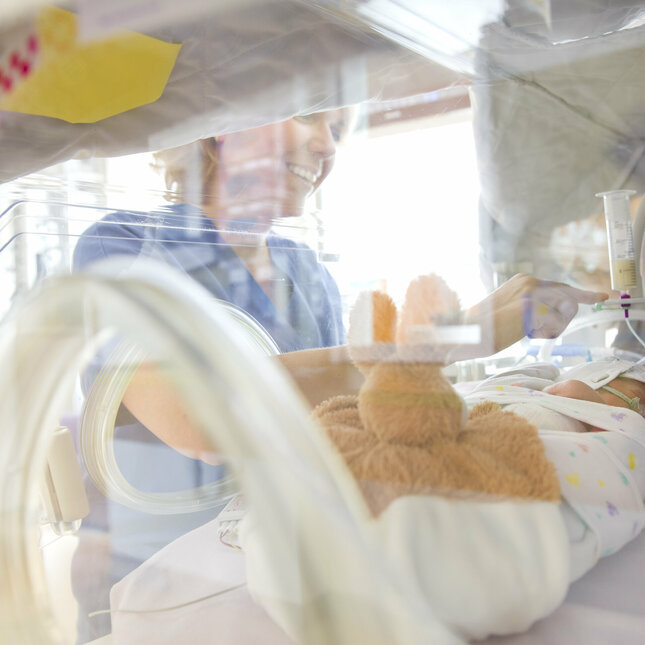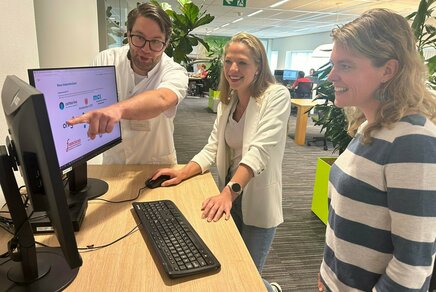Steps towards a safe and silent neonatal ICU
Gabriele Varisco explored ways to improve the monitoring of premature infants in neonatal ICUs with a focus on minimizing false alarms and augmenting the detection of apnea in premature infants.
![[Translate to English:] [Translate to English:]](https://assets.w3.tue.nl/w/fileadmin/_processed_/1/3/csm_Varisco%20Banner%20image%20mmc32388_802dfdd578.jpg)
Premature infants are hospitalized in neonatal ICUs where they are monitored to prevent deterioration in their health. During monitoring, alarms can be triggered if there is a critical issue. However, many alarms are false, which can disturb the patient and the family unnecessarily, and can lead to alarm fatigue in caregivers. All of this may result in delayed or even no response to future alarms. For his PhD research, Gabriele Varisco developed methods to improve patient monitoring techniques in order to reduce false alarms for a safer and more silent neonatal ICUs.
Premature infants are at great risk of medical complications given their physiological immaturity. As a result, such infants are continuously monitored in neonatal ICUs (NICUs). If an issue does arise, alarms can be triggered to alert caregivers to the situation, but sometimes there can be false alarms.
“False alarms can lead to stress for the patient and family members, while also forcing caregivers to redirect their attention to the infant in question even though nothing is wrong,” says PhD researcher Gabriele Varisco. “It would be great if the number of false alarms could be reduced.”
Strategy to reduce alarms
In the first part of his research, Varisco, along with his collaborators within e/MTIC, looked at ways to reduce alarms while, at the same time, continuing to monitor the condition of an infant.
“Alarm management in a NICU was improved by first implementing a new alarm management solution and then optimizing the alarms and protocols,” says Varisco. “This led to a significant reduction in critical alarms but at the same time, the patients had better oxygen saturation and fewer critical conditions occurred. This led to improved patient safety.”
After this, Varisco used machine learning to predict when an immediate response by a caregiver was needed. “Information regarding alarms and caregivers’ responses recorded from past records were used to estimate when future responses might be needed. The results that we found are promising and might lead to the definition of new, more relevant alarms in the future”.
Finally, Varisco used different heart rate measures to verify that music therapy interventions, consisting of guitar pieces performed by a music therapist and accompanied by parents’ talks or songs, can lead to reduced stress in premature infants, leading to improved patient stability.

Focus on apnea
In the second part of his PhD research, Varisco focused on one on the major problems in premature infants. They have problems regulating their breathing and often stop breathing for a short period of time (apnea). This is associated with various medical complications and a leading cause of false alarms, with some studies showing that up to 65% of alarms for apnea of prematurity that sound in current clinical practice are actually false or irrelevant.
Varisco started by optimizing an algorithm for the detection of apneic events in premature infants. “After this, we simulated apneic events with a cardiorespiratory model to improve the understanding of this condition and found important similarities with real infant data,” says the young researcher.
To improve central apnea detection, he developed a two-step approach, consisting of a first detection of apneic events followed by the use of machine learning models to determine whether each apneic event was a central apnea.
With the best performing model, Varisco and his colleagues were able to obtain 93% correct detections of central apneas followed by a bradycardia (when the heart rate is too slow), which are considered the most critical.
“In one final study, a multichannel detection model based on machine learning was developed to detect central apneas directly from physiological signals,” notes Varisco. “The new model returned a precision and recall comparable to the optimized algorithm from our previous study, whilst being much faster without the two-steps. This allows for possible future implementation in clinical patient monitors.”
“In this research carried out by my colleagues and I, we have shown that the safe reduction of alarms in NICUs is feasible through workflow optimization, a revision of the protocols, the introduction of new therapy interventions as well as through the use of machine learning for the detection of the needs of caregiver response and central apnea. We are now interested in expanding this research with data from different hospitals to validate the promising results that we have obtained so far,” says Varisco.
Additional information
This project was performed within e/MTIC, in a project involving Eindhoven University of Technology (TU/e), Máxima Medical Center, and Philips, and the project was funded by NWO-TTW in a project called ALARM.
Gabriele Varisco defended his PhD thesis at the department of Applied Physics (TU/e) on March 21st.
Title of PhD thesis: Monitoring the critical newborn – Towards a safe and more silent neonatal intensive care unit. Supervisors: Carola van Pul, Xi Long, and Peter Andriessen.
Media contact
More on Health



Latest news


